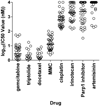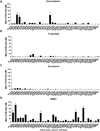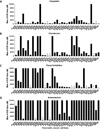Genetically defined subsets of human pancreatic cancer show unique in vitro chemosensitivity
- PMID: 22753594
- PMCID: PMC3513499
- DOI: 10.1158/1078-0432.CCR-12-0827
Genetically defined subsets of human pancreatic cancer show unique in vitro chemosensitivity
Abstract
Purpose: Pancreatic cancer is the fourth cause of death from cancer in the western world. Majority of patients present with advanced unresectable disease responding poorly to most chemotherapeutic agents. Chemotherapy for pancreatic cancer might be improved by adjusting it to individual genetic profiles. We attempt to identify genetic predictors of chemosensitivity to broad classes of anticancer drugs.
Experimental design: Using a panel of genetically defined human pancreatic cancer cell lines, we tested gemcitabine (antimetabolite), docetaxel (antimicrotubule), mitomycin C (MMC; alkylating), irinotecan (topoisomerase I inhibitor), cisplatin (crosslinking), KU0058948 (Parp1 inhibitor), triptolide (terpenoid drug), and artemisinin (control).
Results: All pancreatic cancer cell lines were sensitive to triptolide and docetaxel. Most pancreatic cancer cells were also sensitive to gemcitabine and MMC. The vast majority of pancreatic cancer cell lines were insensitive to cisplatin, irinotecan, and a Parp1 inhibitor. However, individual cell lines were often sensitive to these compounds in unique ways. We found that DPC4/SMAD4 inactivation sensitized pancreatic cancer cells to cisplatin and irinotecan by 2- to 4-fold, but they were modestly less sensitive to gemcitabine. Pancreatic cancer cells were all sensitive to triptolide and 18% were sensitive to the Parp1 inhibitor. P16/CDKN2A-inactivated pancreatic cancer cells were 3- to 4-fold less sensitive to gemcitabine and MMC.
Conclusions: Chemosensitivity of pancreatic cancer cells correlated with some specific genetic profiles. These results support the hypothesis that genetic subsets of pancreatic cancer exist, and these genetic backgrounds may permit one to personalize the chemotherapy of pancreatic cancer in the future. Further work will need to confirm these responses and determine their magnitude in vivo.
©2012 AACR.
Conflict of interest statement
The authors disclose a patent licensed to Myriad Genetics (Drs. Hruban and Eshleman); Advisory Board membership in Inostics, Morphotek, Exact Sciences and PGDx (Dr. Vogelstein); Ownership Interest in Personal Genome Diagnostics and Inostics (Dr. Diaz); and Advisory Board membership in Roche Molecular Diagnostics (Dr. Eshleman). No potential conflicts of interest were declared by other authors.
Figures






Similar articles
-
Immunohistochemically detected expression of 3 major genes (CDKN2A/p16, TP53, and SMAD4/DPC4) strongly predicts survival in patients with resectable pancreatic cancer.Ann Surg. 2013 Aug;258(2):336-46. doi: 10.1097/SLA.0b013e3182827a65. Ann Surg. 2013. PMID: 23470568
-
Genomic sequencing of key genes in mouse pancreatic cancer cells.Curr Mol Med. 2012 Mar;12(3):331-41. doi: 10.2174/156652412799218868. Curr Mol Med. 2012. PMID: 22208613 Free PMC article.
-
Identification and characterization of a novel anticancer agent with selectivity against deleted in pancreatic cancer locus 4 (DPC4)-deficient pancreatic and colon cancer cells.Pancreas. 2009 Jul;38(5):551-7. doi: 10.1097/MPA.0b013e31819d7415. Pancreas. 2009. PMID: 19276868
-
Clinical Effect of Driver Mutations of KRAS, CDKN2A/P16, TP53, and SMAD4 in Pancreatic Cancer: A Meta-Analysis.Genet Test Mol Biomarkers. 2020 Dec;24(12):777-788. doi: 10.1089/gtmb.2020.0078. Genet Test Mol Biomarkers. 2020. PMID: 33347393
-
[Genetic aspects of pancreatic cancer].Eksp Klin Gastroenterol. 2014;(10):70-6. Eksp Klin Gastroenterol. 2014. PMID: 25911935 Review. Russian.
Cited by
-
The Landscape of Pancreatic Cancer Therapeutic Resistance Mechanisms.Int J Biol Sci. 2016 Jan 27;12(3):273-82. doi: 10.7150/ijbs.14951. eCollection 2016. Int J Biol Sci. 2016. PMID: 26929734 Free PMC article. Review.
-
APE1/Ref-1 knockdown in pancreatic ductal adenocarcinoma - characterizing gene expression changes and identifying novel pathways using single-cell RNA sequencing.Mol Oncol. 2017 Dec;11(12):1711-1732. doi: 10.1002/1878-0261.12138. Epub 2017 Oct 19. Mol Oncol. 2017. PMID: 28922540 Free PMC article.
-
The RING Finger E3 Ligase RNF25 Protects DNA Replication Forks Independently of its Canonical Roles in Ubiquitin Signaling.bioRxiv [Preprint]. 2025 Jan 9:2025.01.09.632184. doi: 10.1101/2025.01.09.632184. bioRxiv. 2025. Update in: Nat Commun. 2025 Aug 5;16(1):7214. doi: 10.1038/s41467-025-62368-8. PMID: 39829812 Free PMC article. Updated. Preprint.
-
The effects of NLRP3 inflammasome inhibition by MCC950 on LPS-induced pancreatic adenocarcinoma inflammation.J Cancer Res Clin Oncol. 2020 Sep;146(9):2219-2229. doi: 10.1007/s00432-020-03274-y. Epub 2020 Jun 7. J Cancer Res Clin Oncol. 2020. PMID: 32507974 Free PMC article.
-
Establishment and Molecular Characterization of Two Patient-Derived Pancreatic Ductal Adenocarcinoma Cell Lines as Preclinical Models for Treatment Response.Cells. 2023 Feb 11;12(4):587. doi: 10.3390/cells12040587. Cells. 2023. PMID: 36831254 Free PMC article.
References
-
- Raimondi S, Maisonneuve P, Lowenfels AB. Epidemiology of pancreatic cancer: an overview. Nat Rev Gastroenterol Hepatol. 2009;6:699–708. - PubMed
-
- Shaib YH, Davila JA, El-Serag HB. The epidemiology of pancreatic cancer in the United States: changes below the surface. Aliment Pharmacol Ther. 2006;24:87–94. - PubMed
-
- Burris HA, 3rd, Moore MJ, Andersen J, Green MR, Rothenberg ML, Modiano MR, et al. Improvements in survival and clinical benefit with gemcitabine as first-line therapy for patients with advanced pancreas cancer: a randomized trial. J Clin Oncol. 1997;15:2403–2413. - PubMed
-
- Conroy T, Desseigne F, Ychou M, Bouche O, Guimbaud R, Becouarn Y, et al. FOLFIRINOX versus gemcitabine for metastatic pancreatic cancer. N Engl J Med. 364:1817–1825. - PubMed
MeSH terms
Substances
Grants and funding
LinkOut - more resources
Full Text Sources
Other Literature Sources
Medical
Research Materials
Miscellaneous

